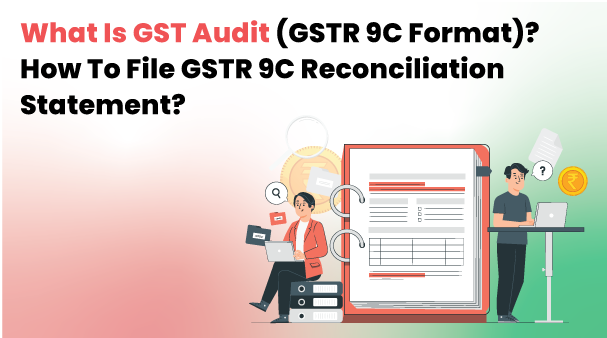Any registered person whose annual income exceeds five crore rupees should get his financial accounts audited according to the CGST Act sub-section (5) of section 35. A copy of all the audited annual accounts and a duly submitted reconciliation statement should be submitted as form GSTR 9C. In a nutshell, the GSTR 9C is a reconciliation statement between yearly returns filed for a financial year in GSTR 9C and the figures according to the audited annual financial statement of accounts of the taxpayer. The reconciliation statement in GST is issued according to GSTIN. Thus, a single PAN cardholder may have to submit multiple GSTR 9C forms.
When to File a GST Audit (GSTR 9C)?
The GSTR 9C due date is December 31st of every year after the corresponding FY audit. The government may extend the deadline as and when necessary. For the financial year 2020-2021, the due date has been extended until February 28th. You must take measures to complete the audit and return filing before the due date.
Who Has to Audit GSTR 9C Form?
The GSTR 9C form should be prepared and certified by a registered Chartered Accountant or Cost Accountant. According to the update in 2022, taxpayers can self-certify the GSRT 9C form. The GSRT 9C form can be submitted online through the GST portal or a facilitation centre. Moreover, a copy of the audited accounts and the annual return form are also required. Since March 16th, 2020, all foreign companies running airlines in compliance with the Companies Act 2013 have been exempted from the GSRT 9C requirement. Non-resident Indians offering OIDAR service to unregistered individuals are exempted from the GSRT 9C requirement.
GSTR 9C Due Date
The reconciliation statement GSTR 9C has to be submitted at the end of every year. However, for the financial year 2021-2022, the GST annual return due date has been extended to 28.02.2022 instead of the usual 31.12.2021.
GSTR 9C Format
The GSTR 9C applicability format has two parts – Part A Reconciliation statement and Part B certification statement.
The reconciliation statement has the following components:
- Basic details
- Reconciliation of turnover declared in Annual Financial Statement with turnover declared in Annual Return (GSTR9)
- Reconciliation of tax paid
- Reconciliation of Input Tax Credit (ITC)
- Auditor’s recommendation on additional liability due to non-reconciliation
The certification statement can be filled in by the person who conducted the audit or by another person who didn’t perform the audit. A relevant part of the certification statement must be filled in for submission.
Is It Mandatory to File a GST Audit (GSTR 9C)?
All taxpayers with a yearly aggregate turnover of five crore rupees for any financial year must submit GSTR 9C. A GSTR 9C reconciliation statement along with audit certification must be submitted. Exemptions listed below are provided for the GSTR 9C audit:
● Casual taxpayer
● Government departments
● Input service distributor (ISD)
● E-com aggregators collecting tax at source (TCS)
● Taxpayers deducting tax at source (TDS)
● Taxpayers with aggregated annual turnover less than five crore rupees
● Composition scheme dealers
● OIDAR service providers
● Non-resident taxpayers
Why Is It Important to File the GSTR 9C Form?
A cost accountant or a chartered accountant is responsible for auditing and preparing the GSRT 9C reconciliation statement. Differences in GST returns details, and the CA reports audited accounts. The GST authorities will use this statement to ensure the correctness of GST returns. Any additional liability that arises from the reconciliation exercise and GST audit of GSTR 9C has to be certified by the CA.
● The GSTR 9 summarises the GSTR 1 return and GSTR 3B return.
● GSTR 1 supplies outward supplies and tax payable.
● GSTR 3B return supplies GST input tax credit and tax paid information.
● Annual return GSTR 9 also includes GSTR 2A return purchase-related information.
● Additional liability, if any, must be paid during annual return filing using form DRC 03.
Eligibility to File GST Audit (GSRTCd)
● A chartered accountant or a cost accountant must duly certify GSTR 9C audit form.
● GSTR 9C form and GSTR 9 annual return must be submitted on the GST portal.
● A copy of the audient accounts must also be submitted.
● The GST auditor must digitally sign the GSTR 9C form.
● GSTR 9C must contain all discrepancies in the GST returns of the taxpayer.
● The GSTR 9C form is an authoritative document that declares your GST compliance to the GST authorities.
● Businesses with annual aggregate turnover exceeding five crore rupees are also eligible for auditing by GST.
How to Download Form GSTR 9C?
The GSTR 9C form can be downloaded from the GST portal.
Step 1: Visit the GST website www.gst.gov.in
Step 2: Go to the Download tab on the home screen
Step 3: Click on offline tools.
Step 4: Download the .zip file and extract it.
Particulars Required for Filing GSTR 9C
The GSTR 9C form consists of two parts – 1. Reconciliation statement 2. Certification.
A GSRT 9C reconciliation statement is required for every GSTIN registered under the PAN. The reconciliation statement has basic details, reconciliation of turnover declared in the audited annual financial statement with turnover declared in annual return GSTR9, reconciliation of tax liability, reconciliation of Input Tax Credit (ITC), an auditor’s recommendation on additional liability due to non-reconciliation.
The certification part has to be filled by a chartered accountant or cost accountant who had conducted the audit. Self-certification is also allowed now afterGSTR returns filing online.
How to file GSTR 9C on the GST portal? Step by step guide
GSTR 9C form must be filed online using the GST portal. The portal contains information to submit a GSRT audit.
Step 1 – Login to www.gst.gov.in
Step 2: In the dashboard, click the Annual Return tab
Step 3: Select the financial year (FY) for submitting GSTR 9C.
Step 4: Click on Initiate E filing
GST Audit Checklist
The following is a checklist for GST audit:
● Reconciliation with GSTR 1 and GSTR 3B
● Taxes on reverse charge mechanism (RCM)
● Interest on late payment of GST if any
● Reversal of ITC for non-payment in 6 months
● Requirement of E-way bill
● Matching of income tax turnover with GST audit turnover
● GSTIN wise audit under the PAN
● Stock transfer
● Bifurcation of availed ITC
● Miscellaneous data gap if any found between inward or outward supplies
The option for self-certification encourages businesses to use an in-house auditing team. Automation is the best way to achieve 100% accuracy. Wepsol is a GST return filing service provider, offering automated submission of the GST return process through the GST reconciliation software that eliminates all the overhead associated with reconciliation and certification of GSTR 9C submission. You need to take advantage of the automated GST return filing online tool for hassle-free GSRT 9C audit and form submission. The software’s user-friendly features with enterprise-level GST compliant solutions simplify the complicated GSTR filing process.
Brand Snippet
Wepsol is a GST return filing service provider, offering automated submission of the GST return process through the GST reconciliation software that eliminates all the overhead associated with reconciliation and certification of GSTR 9C submission. Do you want a hassle-free solution to submitting a GSTR 9C reconciliation statement? Click on Wepsol GST reconciliation software to simplify the complicated return filing process.

